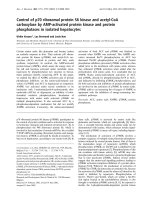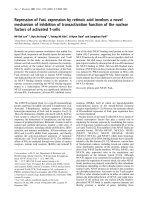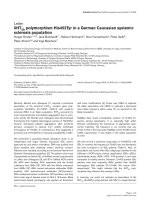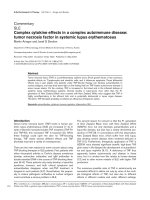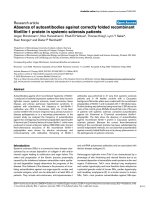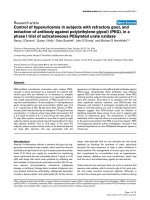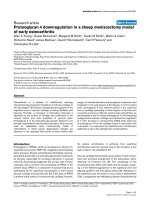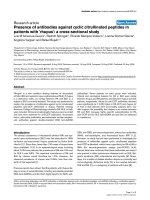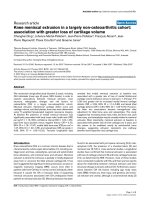Báo cáo y học: "Control of hyperuricemia in subjects with refractory gout, and induction of antibody against poly(ethylene glycol) (PEG), in a phase I trial of subcutaneous PEGylated urate oxidase" potx
Bạn đang xem bản rút gọn của tài liệu. Xem và tải ngay bản đầy đủ của tài liệu tại đây (943.27 KB, 10 trang )
Open Access
Available online />Page 1 of 10
(page number not for citation purposes)
Vol 8 No 1
Research article
Control of hyperuricemia in subjects with refractory gout, and
induction of antibody against poly(ethylene glycol) (PEG), in a
phase I trial of subcutaneous PEGylated urate oxidase
Nancy J Ganson
1
, Susan J Kelly
1
, Edna Scarlett
1
, John S Sundy
1
and Michael S Hershfield
1,2
1
Division of Rheumatology, Box 3049, Duke University Medical Center, Durham, NC 27710, USA
2
Department of Biochemistry, Box 3049, Duke University Medical Center, Durham, NC 27710, USA
Corresponding author: Michael S Hershfield,
Received: 28 Jul 2005 Revisions requested: 21 Sep 2005 Revisions received: 10 Oct 2005 Accepted: 3 Nov 2005 Published: 2 Dec 2005
Arthritis Research & Therapy 2006, 8:R12 (doi:10.1186/ar1861)
This article is online at: />© 2005 Ganson et al.; licensee BioMed Central Ltd.
This is an open access article distributed under the terms of the Creative Commons Attribution License />,
which permits unrestricted use, distribution, and reproduction in any medium, provided the original work is properly cited.
Abstract
PEG-modified recombinant mammalian urate oxidase (PEG-
uricase) is being developed as a treatment for patients with
chronic gout who are intolerant of, or refractory to, available
therapy for controlling hyperuricemia. In an open-label phase I
trial, single subcutaneous injections of PEG-uricase (4 to 24
mg) were administered to 13 such subjects (11 had tophaceous
gout), whose plasma uric acid concentration (pUAc) was 11.3
± 2.1 mg/dl (mean ± SD). By day seven after injection of PEG-
uricase, pUAc had declined by an average of 7.9 mg/dl and had
normalized in 11 subjects, whose mean pUAc decreased to 2.8
± 2.2 mg/dl. At doses of 8, 12, and 24 mg, the mean pUAc at
21 days after injection remained no more than 6 mg/dl. In eight
subjects, plasma uricase activity was still measurable at 21 days
after injection (half-life 10.5 to 19.9 days). In the other five
subjects, plasma uricase activity could not be detected beyond
ten days after injection; this was associated with the
appearance of relatively low-titer IgM and IgG antibodies against
PEG-uricase. Unexpectedly, these antibodies were directed
against PEG itself rather than the uricase protein. Three PEG
antibody-positive subjects had injection-site reactions at 8 to 9
days after injection. Gout flares in six subjects were the only
other significant adverse reactions, and PEG-uricase was
otherwise well tolerated. A prolonged circulating life and the
ability to normalize plasma uric acid in markedly hyperuricemic
subjects suggest that PEG-uricase could be effective in
depleting expanded tissue stores of uric acid in subjects with
chronic or tophaceous gout. The development of anti-PEG
antibodies, which may limit efficacy in some patients, is contrary
to the general assumption that PEG is non-immunogenic. PEG
immunogenicity deserves further investigation, because it has
potential implications for other PEGylated therapeutic agents in
clinical use.
Introduction
Attacks of inflammatory arthritis in patients with gout are trig-
gered by monosodium urate crystals, which result from the low
solubility and high levels of uric acid in plasma and extracellular
fluids [1,2]. Gout can usually be controlled by maintaining
serum urate below the limit of solubility (about 7 mg/dl, or 0.42
mM) with drugs that block urate synthesis by inhibiting xan-
thine oxidase, or that promote renal urate excretion [3]. For var-
ious reasons (noncompliance, intolerance, inadequate
dosage, or inefficacy), therapy fails in a subset of patients, who
may develop destructive arthropathy, widespread deposition
of urate in tissues (tophi), and nephropathy [4]. At this chronic
stage, urate deposits built up over decades are only slowly
depleted by blocking the synthesis of urate, particularly
because the renal clearance of urate is often inefficient in
these patients. The management of chronic gout may be fur-
ther complicated by co-morbidities such as hypertension,
heart disease, diabetes, and renal insufficiency, which may
limit the use of anti-inflammatory agents to treat arthritis.
Urate levels are low and gout does not occur in species that
express urate oxidase, which converts urate to the more solu-
ble and easily excreted compound allantoin. Although in
humans the uricase gene was inactivated by mutations during
ADA = adenosine deaminase; ELISA = enzyme-linked immunosorbent assay; HPLC = high-performance liquid chromatography; mPEG = monometh-
oxyPEG; NPC = p-nitrophenyl carbonate; PBS = phosphate-buffered saline; PEG = poly(ethylene glycol); PEG-uricase = PEG-modified recombinant
mammalian urate oxidase; pUAc = plasma uric acid concentration; pUox = plasma uricase activity.
Arthritis Research & Therapy Vol 8 No 1 Ganson et al.
Page 2 of 10
(page number not for citation purposes)
evolution, parenteral uricase is a potential means of controlling
hyperuricemia and depleting urate stores [5,6]. Infusion of
Aspergillus flavus uricase (Rasburicase; Sanofi Synthelabo) is
used to prevent acute uric acid nephropathy caused by tumor
lysis in patients with leukemia and lymphoma [7,8]. However,
the 18 hour half-life, which necessitates daily infusion, and
potential immunogenicity limit the long-term use of fungal uri-
case, which would be necessary for treating chronic gout.
Covalent attachment of PEG can prolong the circulating life
and diminish the immunogenicity of proteins [9-11]. More than
15 years ago we used a PEGylated bacterial uricase on a
compassionate basis to treat uric acid nephropathy in a
patient with lymphoma who was allergic to the xanthine oxi-
dase inhibitor allopurinol [12]. We have since pursued the
development of a PEGylated recombinant mammalian uricase
as an orphan drug for treating refractory gout. In a preclinical
study, weekly administration of this mammalian PEG-uricase
normalized urate levels and prevented uric acid nephropathy in
a strain of mice in which the uricase gene had been disrupted
[13]. Unmodified recombinant uricase was ineffective and
highly immunogenic, whereas antibodies against uricase were
not detected in mice repeatedly dosed with PEG-uricase.
Here we report results of the initial phase I trial in which mam-
malian PEG-uricase was administered by subcutaneous injec-
tion to human subjects with refractory gout. Single injections
of PEG-uricase resulted in marked and prolonged lowering of
plasma urate concentration. However, in several subjects the
circulating life and efficacy of PEG-uricase was foreshortened
by the induction of antibodies against PEG-uricase, which,
unexpectedly, were specific for PEG rather than for the uricase
protein. This finding conflicts with the general assumption that
PEG is non-immunogenic, and it thus has potential implica-
tions for other PEGylated agents used to treat diverse
diseases.
Materials and methods
Materials
The PEG-uricase used in this clinical trial consists of a recom-
binant mammalian uricase (primarily from pig, with a carboxy-
terminal sequence from baboon), modified by covalent attach-
ment of multiple strands of 10 kDa monomethoxyPEG (10 K
mPEG) per subunit of the tetrameric enzyme [13]. Savient
Pharmaceuticals, Inc. (East Brunswick, NJ, USA) manufac-
tured PEG-uricase and provided it in vials containing 12 mg of
PEG-uricase (195.5 units, assayed as described below) in 1
ml of a phosphate buffer. Savient also provided the unmodified
recombinant mammalian uricase and p-nitrophenyl carbonate
(NPC)-activated 10 K mPEG, which were used to study anti-
body specificity as described below. Other PEG preparations
used in these latter studies were obtained from Sigma (St
Louis, MO, USA).
Study design and subjects
The pharmacokinetics, efficacy, immunogenicity, and safety of
PEG-uricase were investigated in an open-label, single-injec-
tion (subcutaneous), dose-escalation phase I trial, which was
conducted at Duke University Medical Center and sponsored
by Savient Pharmaceuticals. This trial was approved by the
Duke University Investigational Review Board. Study subjects
had symptomatic gout (at least one flare in the previous six
months, chronic arthropathy due to gout, or tophi), and a
serum urate concentration of more than 7 mg/dl. Exclusion cri-
teria included pregnancy, renal failure requiring dialysis, the
use of immunosuppressive agents (other than prednisone at
not more than 10 mg per day to control attacks of arthritis), a
deficiency of glucose-6-phosphate dehydrogenase, or co-
morbidities that might complicate the evaluation of safety.
Allopurinol and uricosuric drugs were withheld for 2 weeks
before, and for 21 days after, the administration of PEG-uri-
case by subcutaneous injection. Groups of four subjects were
scheduled to receive 4, 8, 12, or 24 mg of PEG-uricase. The
response to PEG-uricase was monitored for 21 days after
drug administration. Because of hypersensitivity reactions
observed in three subjects, the trial was stopped after one
subject was enrolled in the 24 mg dose group. The results of
this study have been described previously in preliminary form
[14].
Pharmacokinetics
PEG-uricase was measured as urate oxidase activity in plasma
(pUox) by a modification of a previously described radiochem-
ical HPLC assay [15]. In this modified assay, which was vali-
dated in accordance with recommended standards [16], [8-
14
C]uric acid is oxidized to [
14
C]allantoin during incubation
with study plasma in borate buffer at 37°C. The
14
C-labeled
substrate and oxidation products are then separated by
reverse-phase HPLC (an Agilent 1100 system equipped with
a diode array detector and ChemStation software was used).
Uric acid concentration in the column effluent was monitored
at 292 nm and quantified by reference to a standard calibra-
tion curve.
14
C label in column effluent was measured with a
coupled flow-through radioactivity detector and LauraLite soft-
ware (IN/US Systems, Tampa, FL, USA). The specific radioac-
tivity (counts per second per pmol) of the [8-
14
C]uric acid
substrate determined in this manner, which varies with urate
concentration in the plasma sample, is then applied to the radi-
oactivity (counts per second) in the oxidation product region
of the chromatogram to calculate the amount (pmol) of
14
C-
labeled product formed. The rate of urate oxidation in milliunits
per ml of plasma is then calculated (1 unit = 1 µmol of urate
oxidized per minute).
Pharmacodynamics
Efficacy was assessed by the magnitude of decrease in
plasma uric acid concentration (pUAc). For this measurement,
heparinized blood was immediately placed on ice and centri-
fuged at 2 to 4°C; the resulting plasma was then acidified by
Available online />Page 3 of 10
(page number not for citation purposes)
diluting 1:5 with 0.375 M perchloric acid to inactivate PEG-uri-
case. Uric acid in the acidified plasma was quantified by HPLC
as described above for the pUox assay. To be consistent with
clinical practice and to permit comparison with previous med-
ical literature on gout, pUAc is expressed in 'mg/dl' (1 mM uric
acid = 16.81 mg/dl; a pUAc of 7.0 mg/dl = 0.416 mM).
ELISA to detect IgG antibody against PEG-uricase
Wells of a microtiter plate (Immunlon 2HB; Dynex Technolo-
gies, Chantilly, VA, USA) were coated overnight at 4°C with
50 µl of 50 µg/ml PEG-uricase in PBS, or with PBS ('blank').
After being washed with PBS, all wells were blocked with 1%
BSA in PBS. Dilutions (1:20 to 1:60) of plasma samples were
then added to duplicate wells; 1% BSA in PBS was added to
'blank' wells in quadruplicate. Plates were sealed and incu-
bated for 1 hour at 37°C, then overnight at 4°C. After being
washed with PBS containing 0.1% Tween 20, 100 µl of
1:1,000 or 1:10,000 diluted peroxidase or alkaline phos-
phatase-conjugated goat anti-human γ-chain-specific immu-
noglobulin (Sigma) was added to each well. After incubation
for 1 hour at 22–25°C, plates were washed with PBS (for per-
oxidase-coupled reagents) or Tris-buffered saline (for phos-
phatase-coupled reagents) containing 0.1% Tween 20.
Bound peroxidase or alkaline phosphatase was then detected
by incubation, respectively, with o-phenylenediamine hydro-
chloride and hydrogen peroxide, or with p-nitrophenyl phos-
phate, in accordance with the directions of the supplier.
Absorbance (A) at 405 nm (phosphatase reactions) or at 490
nm (peroxidase reactions) was monitored with a plate reader
(Molecular Devices, Sunnyvale, CA, USA). Peroxidase reac-
tions were terminated by adding 100 µl of 1 M HCl when the
A
490
of the sample with the highest signal reached about 0.2.
Phosphatase reactions were terminated by adding 50 µl of
10% NaOH when A
405
for this sample reached approximately
1.0. (A similar protocol was used to detect IgM antibodies, but
using anti-human µ-chain-specific reagents.)
A 'positive' ELISA response was initially defined as an A
405
or
A
490
more than 3 SD above the mean for day 0 pretreatment
plasma samples from study subjects (subsequently, more than
3 SD above the mean for a panel of healthy control sera sup-
plied by the Duke University Clinical Immunology Laboratory).
Day 14 and day 21 plasma from the study subject with the
highest ELISA response in the initial screen was used as a
'positive' reference in subsequent ELISAs. Studies to estab-
lish specificity for the uricase protein and various PEG prepa-
rations are described in the text and figure legends.
Results
Subject characteristics
The study population consisted of 13 subjects with sympto-
matic gout and hyperuricemia. Nine subjects were intolerant of
allopurinol, or had progressed to a chronic stage despite
ongoing treatment with allopurinol (Table 1). Tophi were
present in 11 subjects. The serum uric acid for all subjects,
measured just before allopurinol washout, was 10.1 ± 2.3 mg/
dl (results are shown as means ± SD throughout) (range 6.9
to 14.7); levels were similar in the six subjects receiving allop-
urinol and in the seven who were not. After the two-week allop-
urinol washout, overall pUAc rose to 11.3 ± 2.1 mg/dl (range
7.5 to 14.9). The two subjects with the highest pUAc (14.8
and 14.9 mg/dl) were brothers with partial deficiency of hypox-
anthine–guanine phosphoribosyltransferase [17]. The underly-
ing basis for gout in the other subjects was unknown. Other
characteristics of the study subjects are listed in Table 1.
Plasma uricase activity and relation to plasma urate
concentration
Before treatment, pUox was undetectable. After subcutane-
ous injection of PEG-uricase, pUox increased gradually, sug-
gesting slow absorption into the circulation. The time to reach
peak pUox (t
max
) varied from 2 to 10 days, averaging 7 days.
Within each dose cohort there were large differences in high-
est and lowest pUox values at each time point. Maximum pUox
(C
max
) values for the groups receiving doses of 4, 8, and 12
Table 1
Characteristics of subjects
Characteristic Value (n = 13)
Sex (F/M) 3/10
Age (years)
Overall 56.1 (40–75)
Females 64.7 (63–66)
Males 53.5 (40–75)
No. of subjects with tophi 11
No. of subjects on medication
Allopurinol 6
Uricosurics 0
Colchicine 3
Prednisone (for gout) 8
Serum uric acid (mg/dl)
Overall 10.1 ± 2.3 (6.9–14.7)
On allopurinol 10.0 ± 2.4 (6.9–14.7)
Not on allopurinol 10.3 ± 2.3 (7.1–13.8)
Serum creatinine (mg/dl) 1.6 ± 0.5 (0.9–2.5)
No. of subjects with co-morbidity
Osteoarthritis 3
Hypertension 7
Heart disease 2
Diabetes 1
Where errors are shown, results are means ± SD; numbers in
parentheses are ranges. Serum uric acid and serum creatinine were
measured before allopurinol washout.
Arthritis Research & Therapy Vol 8 No 1 Ganson et al.
Page 4 of 10
(page number not for citation purposes)
mg were in the ranges 4.9 to 7.5, 8.1 to 21.4, and 6.2 to 13.6
mU/ml, respectively; C
max
was 25.6 mU/ml in the single sub-
ject who received a 24 mg dose.
In spite of variable pharmacokinetics, in every subject there
was a clear inverse relationship between simultaneously
measured levels of pUox and pUAc (shown for the 8 mg dose
cohort in Figure 1). The average time for pUAc to reach a nadir
was seven days, coinciding with the C
max
for pUox. Overall,
pUAc decreased by 7.9 ± 2.8 mg/dl from the pre-injection
level; the nadir was less than 6.5 mg/dl in 11 subjects (2.8 ±
2.2 mg/dl).
The relationship of pUAc to dose of PEG-uricase and time
after injection is shown in Figure 2a. In all dose cohorts the
mean pUAc on day 7 was less than 7 mg/dl; values were 3.2
± 2.6 and 1.8 ± 1.5 mg/dl for the 8 and 12 mg cohorts,
respectively. At 21 days after injection the mean pUAc in the
8 and 12 mg dose cohorts was 6.0 ± 3.3 and 5.2 ± 3.2 mg/
dl, respectively, and was 1.2 mg/dl in the subject treated with
24 mg of PEG-uricase.
Two pharmacokinetic patterns of PEG-uricase
elimination
The time at which uricase activity disappeared from plasma
(and area-under-curve calculations, not shown), defined two
distinct patterns, which were independent of PEG-uricase
dose (Figure 3). In eight subjects ('long-circulating', Figure
3a), pUox was still measurable at three weeks after injection,
whereas in five subjects ('early elimination', Figure 3b) pUox
could not be detected beyond day 10 after injection. The esti-
mated terminal half-life (t
1/2
) of PEG-uricase for the 'long-circu-
lating' group ranged from 10.5 to 19.9 days (t
1/2
could not be
accurately determined for 'early elimination' subjects).
Not surprisingly, the effect of PEG-uricase on pUAc was more
prolonged in the 'long-circulating' than in 'early elimination'
subjects, even though the pre-dose pUAc was higher in the
former than the latter (12.3 ± 2.0 versus 9.9 ± 1.6 mg/dl).
Mean pUAc declined to about 3.5 mg/dl at day 7 after injec-
tion in both groups, but whereas pUAc remained below 6 mg/
dl (5.2 ± 3.9) on day 21 in the 'long-circulating' group, pUAc
rebounded to more than 7 mg/dl by day 14, and to pretreat-
ment levels by day 21, in the 'early elimination' group (Figure
2b).
Immunogenicity
The rapid disappearance of pUox in five subjects, some of
whom had apparent hypersensitivity reactions (see below),
suggested an immune-mediated response to PEG-uricase. An
initial screening ELISA performed on 1:100 dilutions of day 0,
14, and 21 sera failed to detect IgG antibodies against
unmodified recombinant uricase in any of the 13 subjects
(data not shown). A second screening was therefore per-
Figure 1
Plasma uricase activity and plasma uric acid concentration after subcutaneous injection of PEG-uricasePlasma uricase activity and plasma uric acid concentration after subcutaneous injection of PEG-uricase. A single 8 mg injection of PEG-modified
recombinant mammalian urate oxidase (PEG-uricase) was administered. The horizontal axis indicates days after dosing.
Available online />Page 5 of 10
(page number not for citation purposes)
formed at 1:20 and 1:60 dilutions of plasma, using PEG-uri-
case as the immobilized antigen. None of the eight subjects in
the 'long-circulating' group gave a positive response (data not
shown). By contrast, all five 'early elimination' subjects were
consistently positive in this ELISA screen, and in other tests for
antibody against PEG-uricase.
The evolution of IgM and IgG antibody against PEG-uricase
and the relationship to circulating levels of PEG-uricase
(pUox) was examined for each subject in the 'early elimination'
group. Figure 4 shows results for subjects 002, 013, and 011.
In each case, IgM antibody became detectable between 3 and
7 days after injection, preceding the appearance of IgG anti-
body at between days 7 and 14. End-point titers for IgG anti-
body against PEG-uricase in day 21 samples of the five 'early
elimination' subjects ranged from about 1:110 to 1:310 (Fig-
ure 5). The highest titers were found in subjects 002 and 013
in the 4 mg and 12 mg dose cohorts, respectively.
Because IgG antibody was not detected until pUox was
declining or undetectable, it might have evolved earlier but
have been sequestered in complexes with circulating antigen
that were rapidly cleared, or circulating antigen might have
prevented antibody from binding to immobilized PEG-uricase
in the ELISA. To test the latter possibility we examined the abil-
ity of exogenous PEG-uricase to inhibit the ELISA response of
day 21 plasma samples from subjects 002, 003, 011, and 013
(in which uricase activity was undetectable). At the highest
concentration of PEG-uricase tested in this experiment, which
was more than tenfold higher than levels of pUox encountered
Figure 2
Relationship of dose of PEG-uricase and serum or plasma uric acid concentrationRelationship of dose of PEG-uricase and serum or plasma uric acid concentration. (a) Data for each dose cohort. (b) Data for two groups of sub-
jects with distinct pharmacokinetic patterns: 'long-circulating' (plasma uricase activity (pUox) present three weeks after injection (n = 8)) and 'early
elimination' (pUox undetectable beyond 10 days after injection (n = 5)). The horizontal axis indicates days after injection of PEG-modified recom-
binant mammalian urate oxidase (PEG-uricase); 'pre*', serum obtained at screening, just before the two-week allopurinol washout period; 'd 0',
plasma obtained immediately before PEG-uricase injection.
Figure 3
Two pharmacokinetic patterns after single subcutaneous injections of PEG-uricaseTwo pharmacokinetic patterns after single subcutaneous injections of PEG-uricase. (a) 'Long-circulating' group: eight subjects with uricase activity
present in plasma at 21 days after injection. (b) 'Early elimination' group: five subjects with undetectable plasma uricase activity beyond 10 days
after injection. The keys indicate the dose of PEG-modified recombinant mammalian urate oxidase (PEG-uricase).
Arthritis Research & Therapy Vol 8 No 1 Ganson et al.
Page 6 of 10
(page number not for citation purposes)
in the clinical trial, the ELISA signal was still 43 to 77% of that
observed in the absence of added PEG-uricase. Therefore, it
seems unlikely that circulating PEG-uricase masked the devel-
opment of anti-PEG-uricase IgG.
Specificity of anti-PEG-uricase antibody
In the competition experiment shown in Figure 6a, preincubat-
ing antibody-positive day 14 plasma from subject 013 with up
to 200 µg/ml unnmodified recombinant uricase did not inhibit
the ELISA, indicating that the protein moiety of PEG-uricase
did not react with anti-PEG-uricase antibody. By contrast,
PEG-uricase itself completely inhibited the ELISA, as did 10 K
mPEG-glycine, the PEG moiety of PEG-uricase conjugated
with glycine instead of enzyme. (In a similar experiment not
shown, free 10 kDa PEG diol was as effective an inhibitor of
the ELISA as 10 K mPEG-glycine.) Strong inhibition also
occurred with PEGylated Escherichia coli purine nucleoside
phosphorylase, a hexameric bacterial enzyme modified with
multiple strands of 5 K mPEG [18].
Lower-molecular-mass PEGs also inhibited the anti-PEG-uri-
case ELISA, but were less potent than 10 K mPEG (Figure
6b). The approximate concentration necessary to achieve
50% inhibition was 7 µg/ml for 10 K and 5 K mPEG-glycines
(0.7 µM and 1.4 µM, respectively), 60 µg/ml (30 µM) for 2 K
mPEG, and 160 µg/ml (450 µM) for mPEG of molecular mass
350 kDa (the latter two mPEGs were neither activated nor
conjugated with either a protein or an amino acid).
To demonstrate specificity more directly, we developed ELI-
SAs with PEGs, rather than PEG-uricase, to coat the plate. In
preliminary experiments, specific signals could be obtained
with NPC-activated mPEG and mPEG-glycine, but not with
mPEG itself. Because mPEGs, when in solution, did inhibit in
competition experiments (for example Figure 6b),
unconjugated or non-activated PEG might not bind well to the
ELISA plate.
Figure 7 is an experiment in which NPC-activated 5 K and 10
K mPEGs, or PEG-uricase, were used to coat wells of an
ELISA plate, which was then used to test for binding of IgG
present in the day 0 and day 21 plasma samples from the five
'early elimination' subjects. None of their day 0 samples
reacted with any of the three antigens, whereas all day 21
samples reacted with all three antigens, with responses to 10
K mPEG ranging from 0.6 to 2.2-fold those to PEG-uricase.
Figure 4
Time course of appearance of IgM and IgG antibodies against PEG-uri-case, and of plasma uricase activity, in 'early elimination' subjects 002, 011, and 013Time course of appearance of IgM and IgG antibodies against PEG-uri-
case, and of plasma uricase activity, in 'early elimination' subjects 002,
011, and 013. Subject 002 received 4 mg, and subjects 011 and 013
each received 12 mg, of PEG-modified recombinant mammalian urate
oxidase (PEG-uricase).
Figure 5
Titer of ELISA for IgG antibody against PEG-uricaseTiter of ELISA for IgG antibody against PEG-uricase. The data shown
are for the five subjects who showed early elimination of plasma uricase
activity. PEG-uricase, PEG-modified recombinant mammalian urate
oxidase.
Available online />Page 7 of 10
(page number not for citation purposes)
The results confirm that all five subjects had developed IgG
antibody against PEG after treatment with PEG-uricase.
Lack of inhibition of uricase activity by antibody against
PEG-uricase
Aliquots of plasma from a subject in the 'long-circulating'
group, in which there was uricase activity but had no detecta-
ble antibody against PEG-uricase, were mixed with either pre-
treatment plasma (control) or anti-PEG-uricase-positive
plasma that had no uricase activity. The mixtures were then
assayed for uricase activity. The expected level of uricase
activity was observed, indicating that antibody against PEG-
uricase had no inhibitory (neutralizing) effect on PEG-uricase
(data not shown).
Safety and tolerability
Six subjects experienced induration and mild to moderate pain
at the injection site within a few hours of subcutaneous injec-
tion of PEG-uricase, which resolved within 24 to 48 hours. In
addition, three of the five 'early elimination' subjects (one in the
4 mg cohort and two in the 12 mg cohort) developed a second
'late' injection site reaction beginning at 8 to 9 days after injec-
tion. In the first case, local swelling and erythema was diag-
nosed as cellulitis; an antibiotic was administered and the
reaction resolved within 48 hours. In the two subsequent
instances of late reactions, urticaria appeared at the injection
site, and then became widespread within 1 to 2 days. The gen-
eralized urticarial eruption was associated with diffuse arthral-
gia without inflammatory arthritis. No angioedema, respiratory
distress, or change in hemodynamic status was observed. The
urticaria subsided spontaneously within a few days in one
case, and in the other subject after a course of oral pred-
nisone. Six subjects developed gout flares during the 21-day
period of observation after injection of PEG-uricase.
Discussion
Efficacy of PEG-uricase
In this first phase I trial, single subcutaneous injections of 4 to
24 mg of PEGylated mammalian uricase were administered to
13 markedly hyperuricemic subjects with severe gout. PEG-
uricase was slowly absorbed, but by day 7 after injection pUAc
had declined by an average of about 8 mg/dl, and had normal-
ized in 11 subjects whose mean pUAc on day 7 had declined
to 2.8 ± 2.2 mg/dl. At doses of 8, 12, and 24 mg the mean
pUAc at 21 days after injection remained 6 mg/dl or less,
which is considered the therapeutic target for management of
gout with the currently available drugs to which these patients
were refractory or intolerant [19].
The duration of the effect on pUAc correlated with the level
and persistence of uricase activity in plasma. Circulating life
was independent of dose, and was determined less by the
extent of absorption than by the rate of enzyme clearance from
plasma. In eight subjects pUox remained detectable for the full
21-day period of observation. The terminal half-life of PEG-uri-
case in these subjects ranged from 10 to 20 days, or about 13
to 26-fold longer than that reported for the non-PEGylated fun-
gal uricase used to treat acute uric acid nephropathy. These
pharmacokinetic and pharmacodynamic findings suggest that
PEG-uricase could be very effective for controlling hyperuri-
cemia in subjects with severe, refractory gout.
Induction of anti-PEG antibodies
IgG antibody against PEG-uricase developed in five subjects
at about seven days after injection. Remarkably, these antibod-
ies showed specificity for the PEG rather than the protein moi-
ety of PEG-uricase. The relatively low-titer antibodies did not
Figure 6
Competition ELISA to determine the specificity of IgG antibody against PEG-uricaseCompetition ELISA to determine the specificity of IgG antibody against
PEG-uricase. Increasing amounts of the indicated materials were
added to aliquots of plasma obtained from subject 013 on day 14 after
subcutaneous injection of 12 mg of PEG-modified recombinant mam-
malian urate oxidase (PEG-uricase). After incubation overnight, these
mixtures were tested at a 1:60 dilution in the ELISA for IgG antibody
against PEG-uricase. (a) 'Uricase' is the unmodified recombinant pro-
tein used in PEG-uricase, and 'PEG 10000' is 10 K monomethoxyPEG
(mPEG) conjugated with glycine instead of uricase protein. 'PEG-PNP'
is bacterial purine nucleoside phosphorylase conjugated with mPEG of
molecular mass 5 kDa, prepared as described [18]. (b) 'PEG 350' and
'PEG 2000' are unconjugated, nonactivated mPEGs of molecular
masses 350 and 2,000 Da. 'PEG 5000' and 'PEG 10000' are p-nitro-
phenyl carbonate-activated mPEGs of the indicated molecular masses
conjugated with glycine.
Arthritis Research & Therapy Vol 8 No 1 Ganson et al.
Page 8 of 10
(page number not for citation purposes)
inhibit uricase catalytic activity but caused a rapid clearance of
circulating uricase activity, presumably by crosslinking PEG
strands tethered to the enzyme. We speculate that binding of
antibody against still unabsorbed PEG-uricase initiated the
late injection site reactions observed at 8 to 9 days after dos-
ing in three of these subjects.
The earlier appearance of IgM than IgG antibody (class
switching), as well as an apparent anamnestic response
observed recently upon re-challenge of an antibody-positive
phase I trial subject with PEG-uricase (not shown), are char-
acteristics of a T cell-dependent immune response. Factors
that might have promoted this response are the following:
1. Subcutaneous administration and slow absorption would
expose PEG-uricase to dermal dendritic cells, which are
important in T cell priming.
2. The large size of PEG-uricase (molecular mass about 500
kDa) might have stimulated its pinocytosis or phagocytosis
and subsequent processing by dendritic cells, or by macro-
phages [20,21]. It is unclear at present how flexible and inert
PEG molecules might undergo processing.
3. Uric acid crystals have been shown to activate dendritic
cells and to act as an adjuvant in mice [22]. This effect in mice,
which express uricase, might have been due to hydrogen per-
oxide, a byproduct of urate oxidation [23]. Either directly or
through the generation of H
2
O
2
, extensive deposits of urate
crystals in tissues of humans with inadequately treated gout
might act as a potent adjuvant to promote an immune
response to subcutaneously injected PEG-uricase. H
2
O
2
derived from urate oxidation might also have caused the tran-
sient local inflammation observed in several subjects a few
hours after injection.
Erythrocytes have very high levels of catalase, which serves to
eliminate H
2
O
2
generated intravascularly [24]. This potentially
protective function, as well as an expectation of improved bio-
availability, prompted a second phase I trial of intravenous
PEG-uricase. Although confirming the induction of anti-PEG
antibodies, no infusion reactions or allergic phenomena were
observed in the 24 subjects in that trial (data not shown). Fur-
ther clinical investigation of intravenous PEG-uricase is in
progress.
Relationship to other PEGylated therapeutics
The clinical value of PEGylation was first shown with PEG-
adenosine deaminase (PEG-ADA, Adagen
®
; Enzon Pharma-
ceuticals) [25], which has been used since 1990 as replace-
ment therapy for immune deficiency due to inherited ADA
deficiency. PEGylation has since been used to enhance the
therapeutic utility of several other proteins, as well as lipo-
somes, low-molecular-mass drugs, oligonucleotides, lipids,
and polysaccharides [11]. Among preparations now in clinical
use are PEG-asparaginase for treating leukemia, PEGylated
interferons for hepatitis C, PEGylated granulocyte colony-
stimulating factor for neutropenia, a PEGylated liposomal
doxyrubicin for chemotherapy, and a PEGylated antisense oli-
gonucleotide for macular degeneration.
That PEGylation prolongs the circulating life of proteins is well
documented, but it usually does not completely abolish their
immunogenicity. Thus, 8 to 9% of PEG-ADA-treated patients
Figure 7
Comparison of ELISAs performed with mPEGs and PEG-uricaseComparison of ELISAs performed with mPEGs and PEG-uricase. ELISA plates were coated with 2.5 µg of PEG-modified recombinant mammalian
urate oxidase (PEG-uricase) or with 25 µg of p-nitrophenyl carbonate-activated monomethoxyPEGs (mPEGs) of molecular mass 5 kDa (mPEG-5K)
or 10 kDa (mPEG-10K). After washing, the plates were blocked with 1% BSA, 1% glycine in PBS. The indicated plasma samples obtained on day 0
or day 21 after subcutaneous injection of PEG-uricase were then assayed with each substrate at a dilution of 1:50 as described in the Materials and
methods section for the PEG-uricase ELISA.
Available online />Page 9 of 10
(page number not for citation purposes)
develop neutralizing IgG antibodies against ADA protein
[26,27]. Antibodies against L-asparaginase, and against inter-
ferons α-2a and α-2b, have been observed in a relatively small
percentage of patients treated with their PEGylated deriva-
tives [28,29] (and package insert information provided for
these products). In the present case, PEGylation does seem
to have served the intended purpose of preventing the devel-
opment of antibodies against uricase, which is a foreign pro-
tein in humans.
Antibodies against PEG have been generated in rabbits and
mice immunized with PEGylated proteins, including uricase
from Candida utilis, in the presence of Freund's adjuvant [30-
32]. However, in contrast to anti-protein antibodies, a recent
review found no reports of PEG-specific antibody in connec-
tion with the clinical use of any PEGylated therapeutic in
humans [11]. In agreement with this, we have not detected
antibodies against PEG in any patient receiving PEG-ADA,
including in those treated for longer than a decade (MSH,
unpublished data). The immune response to PEG-uricase
might conceivably be related to the linkage between mPEG
strands and lysine residues of uricase. However, our findings
do not suggest such specificity. Thus, we observed reactivity
with PEG-PNP, which employs a succinyl linker, with mPEGs
linked to glycine by means of a carbamate bond, and with
PEGs unlinked to any amino acid.
It is unclear whether systematic testing for anti-PEG antibody
has been performed with other PEGylated therapeutics. How-
ever, low-titer IgM anti-PEG antibodies were detected in 50%
of allergy patients after a 1-year course of allergen immuno-
therapy with PEGylated ragweed and bee venom allergens;
this frequency declined by about half after two years of treat-
ment [33]. It was concluded that anti-PEG antibodies were of
no clinical significance. It is interesting that naturally occurring
anti-PEG antibodies were detected in about 0.2% of healthy
blood donors and 3.3% of untreated allergic patients [33].
From our limited experience with PEG-uricase, it is possible
that 'naturally occurring' antibodies that cross-react with PEG
could affect the clinical efficacy of some PEGylated proteins.
Conclusion
In this phase I trial PEGylated mammalian uricase had a pro-
longed half-life in plasma, and single subcutaneous injections
of 4 to 12 mg corrected marked hyperuricemia for up to three
weeks in subjects with severe, refractory gout. We observed
for the first time in a clinical trial of a PEGylated protein the
induction of IgG antibodies against PEG, a phenomenon with
possible relevance to other PEGylated therapeutics. Antibod-
ies against PEG-uricase may limit its use in a subset of
patients. However, because antibody titers were relatively low,
adjustment of dose, route, or schedule of administration may
preserve efficacy and limit adverse reactions. With continued
treatment, antibody against PEG-uricase may resolve sponta-
neously in some cases, because animal studies suggest that
PEGylated proteins are toleragenic [34-36]. Strategies might
also be devised to minimize the immune response. PEG-uri-
case could provide a more effective method of treating refrac-
tory gout than is currently available, and its uricolytic action
may provide a more rapid means of resolving tophi than can be
achieved by blocking urate synthesis.
Competing interests
MSH and SJK, along with scientists from Mountain View Phar-
maceuticals, Inc. (Menlo Park, CA), are co-inventors of mam-
malian PEG-uricase and are among the holders of patents on
PEG-uricase. Duke University and Mountain View Pharmaceu-
ticals, Inc., have jointly licensed PEG-uricase to Savient Phar-
maceuticals; they could benefit financially if PEG-uricase is
approved and marketed. Because of his involvement in the
development and licensing of PEG-uricase, MSH did not par-
ticipate in the recruitment, consenting, or clinical evaluation of
trial subjects. MSH's laboratory performed the biochemical
and immunologic analyses of coded (anonymous) samples in
the course of this clinical trial, and the data generated are
reported in this manuscript. JSS, who was not involved in the
preclinical development or licensing of PEG-uricase, was the
Principal Investigator of this phase I trial. These arrangements
were in accordance with restrictions established by the Duke
University Medical Center Conflict of Interest Committee.
Authors' contributions
NJG, SJK, and MSH developed and validated the biochemical
and immunologic methods used in this study; NJG and SJK
performed these assays and participated with MSH and JSS
in analyzing the data reported. ES was the clinical coordinator,
and JSS was the Principal Investigator, of the clinical trial. JSS
and MSH participated (with personnel from Savient Pharma-
ceuticals) in designing the clinical protocol. MSH initiated
research to develop a PEGylated mammalian uricase for treat-
ing refractory gout, directed the laboratory investigations
reported, and drafted this manuscript. All authors contributed
to the review of the manuscript and have given approval to the
final version submitted for publication.
Acknowledgements
Judy Fleming and William St. Clair assisted us with ELISA development.
We gratefully acknowledge the willingness of our colleagues to refer
patients for this study, and the dedicated work of the Duke Clinical
Research Unit nurses and laboratory personnel. Savient Pharmaceuti-
cals, Inc., sponsored this phase I trial and participated in the study
design. The sponsor was not involved in the collection, analysis, and
interpretation of data, or in the writing of the manuscript. The sponsor
was given a draft of the manuscript before submission and was informed
of the authors' intent to submit the manuscript for publication. The spon-
sor did not pay publication costs. The trial was conducted on the Gen-
eral Clinical Research Unit at Duke University Medical Center supported
by grant MO1-RR-30, National Center for Research Resources, Clinical
Research Centers Program, National Institutes of Health.
Arthritis Research & Therapy Vol 8 No 1 Ganson et al.
Page 10 of 10
(page number not for citation purposes)
References
1. Becker MA: Hyperuricemia and gout. In The Metabolic and
Molecular Bases of Inherited Disease 8th edition. Edited by:
Scriver CR, Beaudet AL, Sly WS, Valle D. New York: McGraw-Hill;
2001:2513-2535.
2. Wortmann RL, Kelley WN: Gout and hyperuricemia. In Kelley's
Textbook of Rheumatology 6th edition. Edited by: Ruddy S, Harris
ED Jr, Sledge CB. St Louis: WB Saunders; 2001:1339-1371.
3. Terkeltaub RA: Clinical practice. Gout. N Engl J Med 2003,
349:1647-1655.
4. Riedel AA, Nelson M, Joseph-Ridge N, Wallace K, MacDonald P,
Becker M: Compliance with allopurinol therapy among man-
aged care enrollees with gout: a retrospective analysis of
administrative claims. J Rheumatol 2004, 31:1575-1581.
5. London M, Hudson PM: Uricolytic activity of purified uricase in
two human beings. Science 1957, 125:937-938.
6. Kissel P, Lamarche M, Royer R: Modification of uricaemia and
the excretion of uric acid nitrogen by an enzyme of fungal
origin. Nature 1968, 217:72-74.
7. Goldman SC, Holcenberg JS, Finklestein JZ, Hutchinson R, Kreiss-
man S, Johnson FL, Tou C, Harvey E, Morris E, Cairo MS: A rand-
omized comparison between rasburicase and allopurinol in
children with lymphoma or leukemia at high risk for tumor
lysis. Blood 2001, 97:2998-3003.
8. Coiffier B, Mounier N, Bologna S, Ferme C, Tilly H, Sonet A, Chris-
tian B, Casasnovas O, Jourdan E, Belhadj K, et al.: Efficacy and
safety of rasburicase (recombinant urate oxidase) for the pre-
vention and treatment of hyperuricemia during induction
chemotherapy of aggressive non-Hodgkin's lymphoma:
results of the GRAAL1 (Groupe d'Étude des Lymphomes de
l'Adulte Trial on Rasburicase Activity in Adult Lymphoma)
study. J Clin Oncol 2003, 21:4402-4406.
9. Abuchowski A, McCoy JR, Palczuk NC, van Es T, Davis FF: Effect
of attachment of polyethylene glycol on immunogenicity and
circulating life of bovine liver catalase. J Biol Chem 1977,
252:3582-3586.
10. Veronese FM, Harris JM: Introduction and overview of peptide
and protein pegylation. Adv Drug Deliv Rev 2002, 54:453-456.
11. Harris JM, Chess RB: Effect of pegylation on pharmaceuticals.
Nat Rev Drug Discov 2003, 2:214-221.
12. Chua CC, Greenberg ML, Viau AT, Nucci M, Brenckman WD Jr,
Hershfield MS: Use of polyethylene glycol-modified uricase
(PEG-uricase) to treat hyperuricemia in a patient with non-
Hodgkin lymphoma. Ann Int Med 1988, 109:114-117.
13. Kelly SJ, Delnomdedieu M, Oliverio MI, Williams LD, Saifer MGP,
Sherman MR, Coffman TM, Johnson GA, Hershfield MS: Diabetes
insipidus in uricase-deficient mice: a model for evaluating
therapy with poly(ethylene glycol)-modified uricase. J Am Soc
Nephrol 2001, 12:1001-1009.
14. Ganson N, Kelly SJ, Scarlett E, Sundy JS, Hershfield MS: Antibod-
ies to polyethylene glycol (PEG) during phase I investigation
of PEG-urate oxidase (PEG-uricase; Puricase
®
) for refractory
gout [abstract]. Arthritis Rheum 2004, 50:s338.
15. Greenberg ML, Hershfield MS: A radiochemical-high-perform-
ance liquid chromatographic assay for urate oxidase in human
plasma. Anal Biochem 1989, 176:290-293.
16. Guidance for Industry/Bioanalytic Method Validation [http://
www.fda.gov/cder/guidance/index.htm]
17. Kelley WN, Rosenbloom FM, Henderson JF, Seegmiller JE: A spe-
cific enzyme defect in gout associated with overproduction of
uric acid. Proc Natl Acad Sci USA 1967, 57:1735-1739.
18. Hershfield MS, Chaffee S, Koro-Johnson L, Mary A, Smith AA,
Short SA: Use of site-directed mutagenesis to enhance the
epitope-shielding effect of covalent modification of proteins
with polyethylene glycol. Proc Natl Acad Sci USA 1991,
88:7185-7189.
19. Shoji A, Yamanaka H, Kamatani N: A retrospective study of the
relationship between serum urate level and recurrent attacks
of gouty arthritis: evidence for reduction of recurrent gouty
arthritis with antihyperuricemic therapy. Arthritis Rheum 2004,
51:321-325.
20. Ackerman AL, Kyritsis C, Tampe R, Cresswell P: Access of solu-
ble antigens to the endoplasmic reticulum can explain cross-
presentation by dendritic cells. Nat Immunol 2005, 6:107-113.
21. Ackerman AL, Cresswell P: Cellular mechanisms governing
cross-presentation of exogenous antigens. Nat Immunol 2004,
5:678-684.
22. Shi Y, Evans JE, Rock KL: Molecular identification of a danger
signal that alerts the immune system to dying cells. Nature
2003, 425:516-521.
23. Gu Y, Hershfield MS, Cohen A: The danger within. N Engl J Med
2004, 350:2721-2722.
24. Agar NS, Sadrzadeh SMH, Hallaway PE, Eaton JW: Erythrocyte
catalase. A somatic oxidant defense? J Clin Invest 1986,
77:319-321.
25. Hershfield MS, Buckley RH, Greenberg ML, Melton AL, Schiff R,
Hatem C, Kurtzberg J, Markert ML, Kobayashi RH, Kobayashi AL,
et al.: Treatment of adenosine deaminase deficiency with pol-
yethylene glycol-modified adenosine deaminase. N Engl J
Med 1987, 316:589-596.
26. Chaffee S, Mary A, Stiehm ER, Girault D, Fischer A, Hershfield MS:
IgG antibody response to polyethylene glycol-modified ade-
nosine deaminase in patients with adenosine deaminase
deficiency. J Clin Invest 1992, 89:1643-1651.
27. Hershfield MS: Biochemistry and immunology of poly(ethylene
glycol)-modified adenosine deaminase (PEG-ADA). In
Poly(ethylene glycol) Chemistry and Biological Applications
Edited by: Harris JM, Zalipsky S. Washington DC: American
Chemical Society; 1997:145-154.
28. Avramis VI, Sencer S, Periclou AP, Sather H, Bostrom BC, Cohen
LJ, Ettinger AG, Ettinger LJ, Franklin J, Gaynon PS, et al.: A rand-
omized comparison of native Escherichia coli asparaginase
and polyethylene glycol conjugated asparaginase for treat-
ment of children with newly diagnosed standard-risk acute
lymphoblastic leukemia: a Children's Cancer Group study.
Blood 2002, 99:1986-1994.
29. Hawkins DS, Park JR, Thomson BG, Felgenhauer JL, Holcenberg
JS, Panosyan EH, Avramis VI: Asparaginase pharmacokinetics
after intensive polyethylene glycol-conjugated L-asparaginase
therapy for children with relapsed acute lymphoblastic
leukemia. Clin Cancer Res 2004, 10:5335-5341.
30. Caliceti P, Schiavon O, Veronese FM: Immunological properties
of uricase conjugated to neutral soluble polymers. Bioconjug
Chem 2001, 12:515-522.
31. Richter AW, Akerblom E: Antibodies against polyethylene gly-
col produced in animals by immunization with monomethoxy
polyethylene glycol modified proteins. Int Arch Allergy Appl
Immunol 1983, 70:124-131.
32. Cheng TL, Wu PY, Wu MF, Chern JW, Roffler SR: Accelerated
clearance of polyethylene glycol-modified proteins by anti-
polyethylene glycol IgM. Bioconjug Chem 1999, 10:520-528.
33. Richter AW, Akerblom E: Polyethylene glycol reactive antibod-
ies in man: titer distribution in allergic patients treated with
monomethoxy polyethylene glycol modified allergens or pla-
cebo, and in healthy blood donors. Int Arch Allergy Appl
Immunol 1984, 74:36-39.
34. Wilkinson I, Jackson CJ, Lang GM, Holford-Strevens V, Sehon AH:
Tolerance induction in mice by conjugates of monoclonal
immunoglobulins and monomethoxypolyethylene glycol.
Transfer of tolerance by T cells and by T cell extracts. J
Immunol 1987, 139:326-331.
35. Chen Y, Takata M, Maiti PK, Rector ES, Sehon AH: Characteriza-
tion of suppressor T cell clones derived from a mouse toler-
ized with conjugates of ovalbumin and
monomethoxypolyethylene glycol. Cell Immunol 1992,
142:16-27.
36. Lee WY, Sehon AH: Suppression of reaginic antibodies with
modified allergens. I. Reduction in allergenicity of protein aller-
gens by conjugation to polyethylene glycol. Int Arch Allergy
Appl Immunol 1978, 56:159-170.
